#1903 Biography
Explore tagged Tumblr posts
Text
1902-1903 Postcards
In December 1902, Grand Duke Ernst Ludwig began his trip to India and Egypt. During his journey, he sent his daughter, Princess Elisabeth of Hesse, numerous postcards, which are preserved in the Hessian State Archives in Darmstadt.
When he departed in December 1902, Ernst Ludwig left his first “Gruss Haus Darmstadt” postcard for his beloved daughter, where he wrote in English: “Goodbye my darling. God bless you. Papa’s love is always near you, sleeping or walking."
On the outward journey, Grand Duke Ernst Ludwig sent numerous postcards to Elisabeth, e.g. “tender kisses” from Paris or a picture of his hotel in Marseille with details of his balcony.
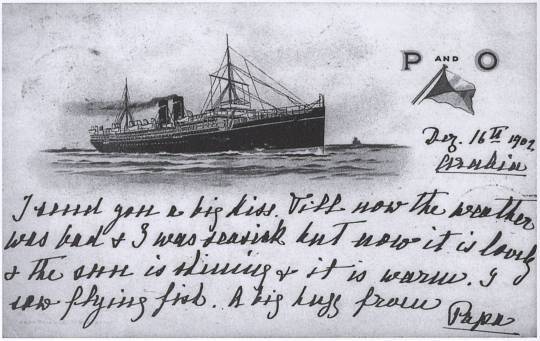
On the postcard above, written on board the Arabia on December 16, 1902, Ernst Ludwig told his daughter: "I send you a big kiss. Till now the weather was bad & I was seasick but now it is lovely & the sun is shinning & it is warm. I saw flying fish. A big kiss from Papa.” He celebrated Christmas on board the "Arabia" and Elisabeth sent him and his entourage a Christmas card.
On January 1, 1903, Ernst Ludwig enthusiastically reported to his daughter about his impressions from Delhi: “All those many people dressed in every color of the rainbow. It was lovely. A big kiss from Papa.” The cards are mostly in black and white, but for her daughter to get a better impression, he also described the colours of everything he saw.

On the postcard above, written on January 15, 1903, he wrote: "This lovely place is all in white marble with a blue (sky ?) & lots of green parrots flying about & screaming. They are green with red beak & a red ring round their necks. Papa"
Almost every day he sent his daughter postcards with picturesque pictures and short, sweet greetings. Postcards with motifs that were exotic to Elisabeth document his journey to destinations in northern India that are still classic today, such as Benares, Agra with the Taj Mahal, Jaipur and Fatehpur Sikri.
At the end of February, Ernst Ludwig finally began his return journey - but made a stopover in Egypt. On March 5, 1903, on a postcard from the Shephard's Hotel, the most famous luxury hotel in Cairo at that time, Ernst Ludwig announced to his daughter what should not be missed on a trip to Egypt: “Today, I go for a week up the Nile.”
On March 11, 1903, he sent birthday greetings to Elisabeth on a card from Aswan. He also visited Luxor and Karnak and, of course, the pyramids of Giza at the end.

On the postcard above, written on March 22, 1903, he proudly reported to Elisabeth about his climb to the pyramids: "I klimbed (sic.) up the pyramid yesterday & got very out of breath. Today I krept (sic.) into the inside. It was very difficult because all was so very slippery. Papa."
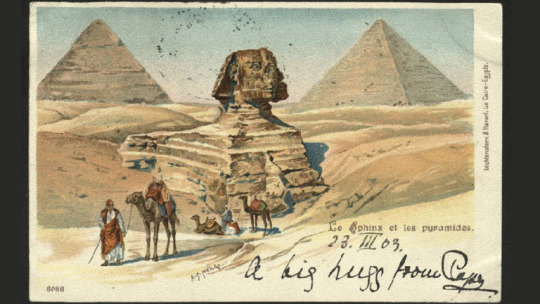
On the postcard above, written on March 23, 1903, Ernst Ludwig sent his daughter "a big hug from Papa".
He finally returned to Darmstadt via Genoa on April 3, 1903. In the following months, Ernst Ludwig continued to send postcards with loving greetings to Elisabeth from his travels through Germany. In one of his last cards, written on August 6, 1903, he told her: “Next time you must come with me.”
source: landesarchivhessen.de Thank you Thomas Aufleger for sharing this little treasure with me!
#princess Elisabeth of Hesse#Grand Duke Ernst Ludwig of Hesse#1902 Letters & Diary entries#1902#1903 Letters & Diary entries#1903#1902 Biography#1903 Biography
28 notes
·
View notes
Text











All the photographs I managed to dig up of him so far!
#eötvös józsef#screams into the void#as one does#he really liked to cross his arms huh#anyway#the first one is my favourite#but i have only found this version on the internet#it's from a 1903 biography#i have seen the og in person tho#at least i think it was the og#i couldn't find anything on it#the third one was his wife's favourite#according to the same biography#i think he didn't like the tenth one#based on an 1865 letter#he found it “bitterish”#and thought that the photographer could have “covered” his graying beard and wrinkles with the “veil of christian love”#altough the tenth one is the one that later made it into the album so it might have been another#i mean#just look at the others#some were probably taken for the same album#also#he is smiling in the sixth one!
0 notes
Note
Which Presidential couple's story would make the best romantic comedy?
This is such a great question, and I was spending quite a bit of time going over the Presidential marriages while debating myself about the right answer. But it suddenly hit me that the perfect answer is Calvin Coolidge and his wife, Grace Goodhue Coolidge. They were extremely quirky as individuals and, as a couple, there are many unique stories about the Coolidges and their marriage. As I've written on a couple occasions in the past, Calvin Coolidge was a really weird dude (he had a mechanical horse in the White House for exercise and was not above dressing up as or acting like a cowboy when using it!), and Grace was eccentric (she had a pet raccoon named Rebecca in the White House) and very interesting in her own right. Together, they were quite a match.

As William A. DeGregorio wrote in The Complete Book of U.S. Presidents, "While watering flowers outside the school [she was working at in Northampton, Massachusetts] one day in 1903, [Grace] happened to look up at the open window of Robert N. Weir's boardinghouse and caught a glimpse of [Calvin] Coolidge, shaving in front of a mirror, with nothing on but long underwear and a hat. She burst out laughing at the sight; he heard the noise and turned to look at her. It was their first meeting."
And as the New York Times reported in a 1935 review of Mrs. Coolidge's biography of President Coolidge:
Soon after Calvin Coolidge was married, he took to his bride fifty-two pairs of socks in need of mending. "When I inquired if their wearer had married me to get his stockings darned, he replied quite seriously, 'No, but I find it mighty handy,'" Mrs. Grace Coolidge writes.
It seems like you could get a lot of comedic mileage out of their relationship. There are, without a doubt, significantly more photos of Grace Coolidge laughing or smiling than all of the First Ladies that preceded her (and a good number of those who followed her) combined.


#History#Presidents#Presidential History#First Families#First Ladies#Presidential Marriages#Presidential Relationships#Calvin Coolidge#President Coolidge#Coolidge Administration#Grace Coolidge#Grace Anna Goodhue Coolidge#White House Pets#Presidential Pets#Rebecca the Raccoon
79 notes
·
View notes
Text
📎 YOSANO AKIKO ANALYSIS
UNDERSTANDING & ANALYZING BUNGOU STRAY DOGS YOSANO THROUGH THE LENSES OF THE REAL YOSANO AKIKO'S LIFE
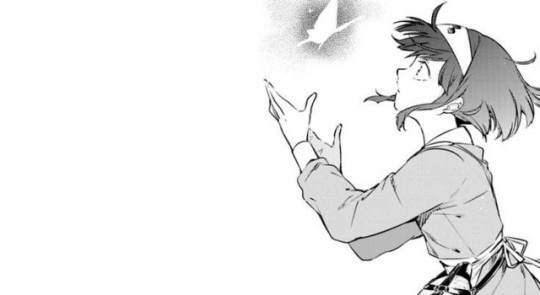
WC. 4,000
DISCLAIMER: I am no historian or literary expert I am just obsessed and mentally unwell, if u cannot tell, teehee <333 If this will ignite any hate or hostility (not this post’s intention), please set your sights elsewhere and just scroll. I made this because I love her character and BSD in general to a bone-shattering degree. I hope you have as much fun as I did while researching and writing this, enjoy!! (also English is not my first language forgive me for any grammatical errors ty)
There might be a part two for this, but for now, this is all my tiny brain could offer >:))
IMPORTANT NOTE: There will be a lot of omitted, summarized information that has been subjectively extracted or abridged. This is not a complete, rich historical account but research done to make connections and parallels to better understand and theorize about BSD Yosano’s character. I did not finish reading the entire biography, which is why this is only the first section of a bigger whole.
However, if you desire to dig deeper about her in an unabridged manner please kindly refer to the source I will list below. One last thing, please don’t hesitate to add your own thoughts, I am encouraging you to do so, I will appreciate it so much actually!
My primary source;; Janine Beichman - Embracing the Firebird_ Yosano Akiko and the Birth of the Female Voice in Modern Japanese Poetry-University of Hawaii Press (2002). [pdf can be downloaded for free @/libgen]
Allow me to initiate this observation with a passage directly extracted from her biography (the one named above):
“Yosano’s father Òtori Sòshichi (1847–1903), was the second-generation owner of the Surugaya, a well-known confectioner that specialized in yòkan (sweet bean paste) and sweet dumplings.”
With this passage in mind, I’d like to remind you of this scene in the manga that hinted at BSD Yosano’s circumstances and background prior to being selected as Mori’s assistant at the fortress. In this panel, she mentioned that she was tending to a candy store before getting drafted.

Now, drawing from the passage we read regarding the real Yosano Akiko and applying this to BSD Yosano—it’s not far-fetched to assume that the candy shop she was tending to was run and owned by her family. Normally, we could say that familial separation, especially at such an early stage of childhood would be quite hard on the child. However, if we consider the following facts from the real Yosano Akiko’s childhood and parallel it to BSD Yosano again, we could conclude that the separation wasn’t as difficult nor emotional for her when Mori selected her, because she was called in this book an ‘infant exile.’
Starting from the very birth of the real Yosano, her father was severely appalled by her because she was a girl. Moreover, he deserted their home for a week without even looking at his daughter’s face. Her mother became distressed because of the week-long absence of her father, (fainted, even) and couldn’t breastfeed her properly, resulting in the infant Yosano being sent to a maternal aunt accompanied by a wet nurse.
Two years later, due to convenience rather than the will to come back, Yosano returned to her familial house because her aunt had a new baby of her own to look after and raise. Though at this time, a new baby was born, too, at the Otoris. And this baby grew up to be the brother to whom the adult Yosano dedicated her poem ‘Thou Shalt Not Die.’
Since the arrival of this baby boy, Yosano’s existence has become easier to tolerate—see this actual snapshot from the passage I am referencing:
‘ while at the Òtori home a baby boy had finally arrived, making it easier to tolerate the unwelcome girl.’
As if to rub in the author’s title for the real Yosano Akiko (infant exile) even their servants and relatives had a distaste for her and her personality, viewing her as the ‘difficult’ child in the family. Here’s another direct quote from the biography book:
‘The relatives chimed in disapprovingly: “‘The younger brother is better behaved; his older sister is a little much.’ From the apprentices to the little uncle on my mother’s side all predicted better things for my younger brother than for me. Having to listen to all that didn’t feel very good.” Even the servants rubbed it in.’
Additionally, Yosano Akiko herself wrote that she never knew the warmth of a mother or father’s lap and that her parents had an inherent antipathy towards her that was not inflicted on her siblings. She wrote, that other women are troubled concerning their in-laws, and how to operate as human beings alongside them but this same worry is her very reality in her own family’s household—blood and flesh—she served her parents as if they were her in-laws and endured hardships by their hand and in their name. Here’s a snippet from the biography:
‘“Other women become brides and struggle to manage a household, but for me it was the reverse: from the time I was a young girl I served my parents as if they were my in-laws, and endured emotional and physical hardships.”’
Another possible factor that enriched an equal sentiment of apathy within Yosano was despite the extremely young age of three she was coerced into attending school—which, as made clear in the biography, was something she disliked. What gave her parents this idea? Well, her father was quite the ardent enthusiast of the science of producing superior human beings. With this belief in mind, it’s no surprise that when he mistook the large forehead of the young Yosano as a sign of intelligence, he sent her to study immediately.
But Yosano was too young, too passionate, and excited still to engage in play with other children, to have fun with her friends because she was hardly above infancy, only three years old. Despite the awareness of the adults around her that she’s not of school age yet, she was shamed for her disagreement—as said to her by one of her maids: “See what a good girl Miss Takenaka is. Aren’t you ashamed of skipping school?”
Are you seeing a parallel? BSD Yosano, although just 11 years old, was chosen by Mori to be the core of his immortal regiment plan, because similar to the real Yosano’s situation somebody (her father) saw something urgent and, perhaps special or advantageous in her which is why she was pushed into studying—in BSD Yosano’s case Mori saw this potential within her and incorporated her into his plans, and drafted her from what seems to be her family’s candy shop.
One thing I’d like to emphasize again is that in this drafting of BSD Yosano, the fact that she agreed or at the very least went along with Mori even if it meant being separated from her family, is because she (if we parallel it once again to the poet Yosano) was never really seen as important or someone capable in her family, they did not have faith in what she can do or her future, they did not have confidence in her character. Regarding this sentiment here are two excerpts from the biography:
‘The restrictions themselves (which were not uncommon then, at least in Sakai) did not hurt as much as the misjudgment of her character and what she might do were she free: “It goes without saying that in a house with many employees, and particularly in a morally lax city like Sakai, a daughter had to be strictly supervised. But there was no need to go that far with a woman who took as many pains to protect herself as I did. I thought the lack of understanding of my feelings that my parents’ attitude showed was outrageous and when alone I often wept over it.”’
And:
‘Like her parents, the teacher hurt her pride by assuming that she was less intellectually and morally advanced than she actually was, but politeness kept her from objecting.
And as stated by the creature in Frankenstein (see how I always find a way to mention it haha): “And tell me why I should pity man more than he pities me?”
Why should she nurture deep affection for her family—relatives and servants too, even her teacher—when they will not reciprocate even a pittance of the same love and care? Or even respect. Take a look at this paragraph from the document:
‘But the results of this parental coldness were not entirely negative. Just as
ignorance of her ancestry liberated Akiko from the weight of family tradition,
so multiple caretakers and the lack of parental affection weakened her sense of
filial obligation.
‘What gave her the strength to defy her family’s expectations
and flee to Tokyo in her early twenties? Surely, the intensity of her love for
Yosano Tekkan and her own literary ambition were most important; but would
a more cherished daughter have been able to make the break so decisively? The
seeds of the later revolt were planted in the infant exile.’
For this very reason, I conclude that if anything, being drafted by Mori was, in the 11-year-old Yosano’s eyes, an opportunity to prove her competence and worth and realize her goal—saving people’s lives (although in this, she has been failed). As a matter of fact there is a compelling possibility that this conviction to save lives was another element of the real Yosano’s personality and beliefs. It has been written in the biography that Yosano Akiko’s father was a fan of stories of heroism, stories that involved the act of protecting and saving, and what makes this relevant is that he also loved sharing these stories with his children.
From a young age, her mind was fed with these noble stories, and children are impressionable. That said, the young Yosano Akiko inherently possessed a special empathy and protectiveness over life, in support of this let us read through another snippet from a passage;
‘One summer when Akiko was around eight she was sitting up there in the evening cool with her siblings and some cousins, when one of the older children remarked, “A night when the moon and the stars are close means fire.” When the others had left, Akiko gazed up at the vastness of the sky. Feeling sorry for the children in any house that might burn and worried that the fire might reach her own house, “I tried to think of some way to increase the distance between the little star and the moon.”’
As additional support, kindly read this excerpt as well:
‘In the morning, Akiko’s parents returned from her sister’s house. As their own manager politely expressed his relief that the Takemura home was unharmed, Akiko thought sadly to herself, “I wouldn’t mind having the Take-muras’ storehouse burn down if only the Gusei girl had not turned into a charred corpse.”’
And the last addition to further highlight this:
‘So much in this story of the great Sakai fire is typical of Akiko’s view of the society in which she grew up. She shows us all the negatives of the situation: People turned out in force either because they wanted to keep the fire from spreading to their own houses or because they enjoyed a good disaster as long as it was someone else’s. Even her own family thought it natural to rejoice that their daughter’s storehouse had been spared rather than grieve for the dead Gusei girl.’
The young poet Yosano Akiko, even compared to the adults in her environment bore within her a deeper reverence for life, the actions of the adults and their selfish concerns did not amuse her, she thought very negatively of them. The grief and pity she felt for the single casualty, the girl, meant that the loss of life be it a loss of what people consider an insignificant person, mattered to her. For her, every death is worth grieving. And should never be a source of entertainment or material for gossip (the villagers made festivals and dances inspired by the incident). Taking all this into account, it’s not much of a shock that BSD Yosano was so driven to save lives, why it mattered to her so strongly, why, she was also so severely devastated about what her ability has been used for.
A brief interlude before further digging into the real poet’s early history, I’d like to draw more emphasis on the previous points made—specifically how she’d rather have the storehouse burn (despite having a mother who’s from a lineage of merchants, and Yosano running the candy shop business as well) if it meant seeing a girl she didn’t know too deeply, live—leaping to the future, the poet’s adulthood, for a moment, to affirm further BSD Yosano’s principles regarding the preciousness of life above all else.
In her most, as called in one article, ‘inflammatory’ poem which is ‘Thou Shalt Not Die’ I want us to focus on this particular line in the poem:
For you, what does it matter if Port Arthur Fortress falls or not?
The poet Yosano Akiko was so adamant in stopping her brother, Port Arthur be damned, because it was common knowledge at that time, false or not, that serving the military was volunteering for your own death—there were rumors of the Japanese soldiers being sent to suicide missions—and for what cause, even? Well, that’s not the right question to ask, let’s correct it to what 11-year-old BSD Yosano expressed in her refusal against Mori’s command to continue healing: Should any cause matter over human life?
Remember, she disagreed when he (Tachihara’s brother) told her that her ability could change the world. She hoped only to save those she could reach. She was aware, of her limits, of the consequences, and that she could not and should not aim for such causes.

Alright, now that we can clearly see how the real Yosano Akiko’s qualities reflect onto BSD Yosano. Back to the early past.
As young as eight, Yosano Akiko tended and shouldered a huge portion of their business’s management, because, as said in the biography her mother was “sickly” while her father was “irresponsible” so she felt that she had to shoulder their responsibilities, here’s a direct quote: ‘ So Akiko felt that she “absolutely had to” stay home and help her parents, managing both the store and the household.’
But because of this, she earned a position of authority in the household, (additionally, by the age of eighteen, she has salvaged the losses from her father’s stock investments.) analogous to—as she stated herself—how a servant acting on behalf of the master can carve out his or her own sphere of autonomy.
Our Yosano, if we again, try to see her in the real author’s light, must have been reminded of the corner she was driven into in her younger years. Reminded, of how the adults around her could so easily burden her with duties disproportionate to her age and how powerless she was after all amidst all of it.
This time though, she had hope; hope that she could start anew and could finally leave behind a life riddled with mistrust, and belittling, that she could choose for herself what she would labor for and dedicate her efforts to.
That—in the absence of her hometown and the people she grew with, the absence too, of admiration and belonging would change.
For a brief moment, it did.
The soldiers adored her, praised her as an angel, and treated her as someone capable—one made her good coffee, drew her a portrait, and Tachihara’s brother even created a present for her with his ability. She was needed not as some fallback for responsibilities nobody wanted. She was necessary, in a way she approved of. She was not a better-than-nothing exile anymore.

Furthermore, quiet acceptance didn't shackle her speech and response to the adults surrounding her in the fortress. The author, Yosano Akiko during her time running the business, often had to put on a polite face and way of speaking to the customers and called out herself when she seemed childish; moreover, she had to endure the incredulity of the prominent figures in her life, and deal with its damages internally. Take this excerpt, for example:
‘Like her parents, the teacher hurt her pride by assuming that she was less intellectually and morally advanced than she actually was, but politeness kept her from objecting. Among her friends, Akiko could be open about her ambition and her pride, but with adults, she apparently felt she had to choose between a pained silence and outward disrespect, and the latter was impossible for her.’
Meanwhile, in the fortress, she could allow herself to be less restrictive with how she interacts with them.

Even with Mori, her superior, she let go of the hesitation to speak her mind. It’s no surprise then, that by the end of it, her spirit was broken.
This opportunity for change—to make a change, meant the entire world to her. At last, she was able to help in the way that matters to her and appeals to her heart, she did not choose to be there because there were no other options. She was there for a purpose she believed in. Her service was met with gratitude, they accepted her presence, not simply tolerated it.
Until things went south.
And it did in ways that reignited the severity of an existing fear within our Yosano. How, and why is this the case?
The poet, until about fifteen years old, nurtured within her as she wrote, an ‘irrational anxiety about death,’ which ‘shaped her inner life.’ As if to fuel her unease, rumors circulated in Sakai (her hometown) about a certain family’s daughter who died bathed in blood after suffering for three days straight. This rumor made the young Yosano Akiko weep, imagining such a kind of suffering. And with these thoughts haunting her, she came up with a specific way in which she would accept death:
‘“If I am to die, let it be at night, so no one will see. I don’t want my suffering exposed to the light of day. I want to breathe my last alone at night in a dark room, letting death’s cruel hands claim me with lips firmly sealed, not a hair of my
head out of place.”’
She even contemplated suicide, since it is the only way for her to die on her own terms.
Oftentimes, though, she’d take what she could to stay distracted from her mortality, which is mostly done by reading:
‘So here, in addition to the intellectual curiosity, the pleasure, and the inner
rebellion that motivated Akiko’s early reading, is another motive: escape from
anxiety about her own mortality.’
She attempted to pacify her thoughts and emotions about death, through religion. However, despite her consideration, she ended up rejecting it. From the age of three or four, she hated the scent of incense being burned, going as far as to rush past the many temples that burned them. She disliked, too, sitting beside her parents with her hands clasped in prayer. Affirming and elaborating more on this, allow me to show you this passage:
‘The Buddhist teachings and legends they told her seemed no more than “fairytales for grownups” that could be of no help to her in “preparing for death.”
Once she “asked if Gautama Buddha had really existed and, if so, what country he had been a citizen of ” and was told that she “would receive divine retribution” for her impertinence.
Every month her mother and her friends heard a lecture by a priest, but as soon as
the lecture was over, the priest would join them in “ordinary gossip, speaking ill of people behind their backs.”
Akiko “realized that these believers were not even one-tenth as serious as I was about... life and death and that even after twenty or thirty years of visiting temples and praying they were still not saved.” If they had no hope, she reasoned, how much less had she. And so she
concluded that it was “useless” for her “to expect to be helped by Jòdo Shin-
shû.”’
What did encapture her, and attract her (as said in the biography) then?
Alongside the stories of heroic virgins in Japanese myths, she too was moved by Sokkyò Shijin which was the Japanese translation of The Improviser, translated by—guess who? Ougai Mori. Yes, him. Now I want you to witness this excerpt from the biography:
‘“I envied the pure, noble life of virgin empresses like the goddess Amaterasu. The imperial virgins of Ise and Kamo also filled me with longing. When I look back now on how I felt then, I think that, while squarely facing reality, I flew off and thought of my future in beautiful, idealistic terms, and wanted to stay a pure, undefiled virgin, like an angel, all my life.”’
Considering the new information, we can once again connect it to our Yosano and conclude that BSD Yosano also shared the poet’s fear of death and mortality. Besides her disconnect with her family, she wanted to prevent others from experiencing the fear of dying in a gruesome and undignified manner, which is why she allowed herself to be drafted for war. If you’ll allow me to speculate further, I’d say dying for her (at least she believed) should be a choice, or at the very least should be aligned with the personal preferences and ideals of the person dying—and this principle of hers, augmented the horror she has felt and has bestowed upon the soldiers because what exactly did the weaponizing of her ability bereave the soldiers of, exactly? The control they have over their own death.

She wanted to save them from death, and she did. Until they didn't want to—until, she didn't want to, anymore. But she, a child, never stood a chance against what she was actually there for. She was there as a tool to convey a new age of weaponry which were abilities.
The scene with Kaji must have allowed these memories to resurface, he called the train bombing incident an experiment, and in a sense she too was an experiment—like the soldiers, she was there to further the idea and be the evidence that abilities were the weapons of the future that will completely change the battlefield, without any guarantee that she or the soldiers would achieve success, or leave intact.
And they didn’t—not them, not her.
For now, this is all I have for our Yosano.
Or is it? Before we end this I’d like to speculate even more about the significance of Mori as a figure in our Yosano’s life—the poet was moved, her heart attached to the real Mori’s use of language in his translation, in how he wrote the nun—perhaps, BSD Yosano put an equal amount of trust and faith in Mori, his intentions, his treatment of her. Given the real Yosano’s experiences and applying the same to our Yosano, she has every reason to be distrustful and skeptical of suddenly being drafted out of all the older, more experienced people by another adult. So there must be something about BSD Mori’s language, too, that persuaded her and moved her the same way the real Yosano was affected by it. For the first time she believed—relied on him, despite experiencing so many disheartening memories dealt to her by older figures in her life.
Okay, I’m serious now, this is the end. I hope you enjoyed and most of all I hope you appreciate her more as a character, that would be the greatest achievement this post could make.
my main is @ice-devourer jic u wanna talk more abt this, THANK YOU SO MUCH FOR READING OMG!
#bsd#bungou stray dogs#bsd analysis#bungou stray dogs analysis#yosano analysis#bsd yosano#bungou stray dogs yosano#mewrites
91 notes
·
View notes
Note
there was Chinese interest in the Out Of Asia theory, in both the Republic, Chiang Republic and People’s Republic periods before the Out Of Africa theory became commonly accepted. Was the 1954 Yeti expedition done just from the Nepalese-Indian side or were the American agents and “anthropologists” given access on the Sino-Tibetan side of the Himalayan border?
During the early part of this century, it was absolutely believed for a long time that the deserts of Western China were the most likely place of human origins, as seen in this migration map from 1944, made from the best available knowledge of the time:

Remember, the oldest fossil remains at this point were in China, where Homo erectus was discovered (originally known by his initial place of discovery in Chungkotien Cave, nicknamed "Peking Man"). The discovery of Australopithecus and Homo habilis in Olduvai Gorge and South Africa, which place human origins in Africa, were not until the 50s and 60s, so it seemed entirely reasonable that Homo sapiens evolved in Western China.
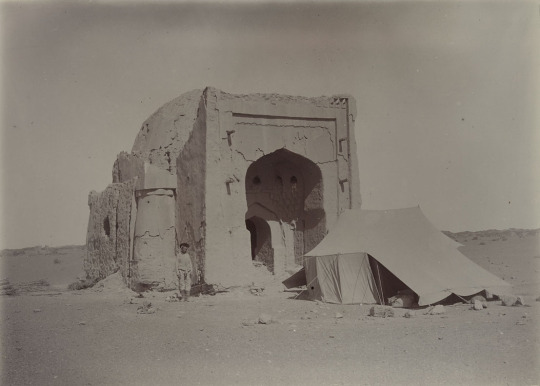
The idea that China's desert regions were the origin of modern humans and culture is seen a lot in pop culture from 1900-1950, mainly because there were tremendous explorations in the region, especially Aurel Stein's expedition of 1908, who ventured into the Taklamakan Desert to find the Dunhuang Caves and Khara-Khoto, a city destroyed completely by Genghis Khan and vanished in the desert.

If you've ever heard of Roy Chapman Andrews and his famous expeditions in the 1920s, it's worth noting that he ventured into the Gobi Desert looking for human remains....not dinosaurs, and the discovery of dinosaur eggs was an unexpected surprise.
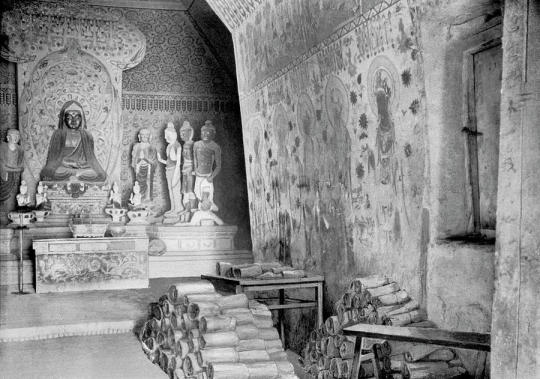

For that reason, there was a short lived Silk Road Mania that seemed to be a smaller scale predecessor to the pop culture dominating Egyptomania of the 1920s. It's bizarre to read adventure and fantasy fiction of the 1910s-1920s that features mentions of Silk Road peoples like the Kyrgyz, Sogdians, Tajik, Uigurians, and Tuvans. The best example I can think of would be the Khlit the Kossack stories of Harold Lamb (who also wrote a biography of Tamerlane), which together with Tarzan and Tros of Samothrace, formed the core inspiration for Robert E. Howard's Conan the Barbarian.
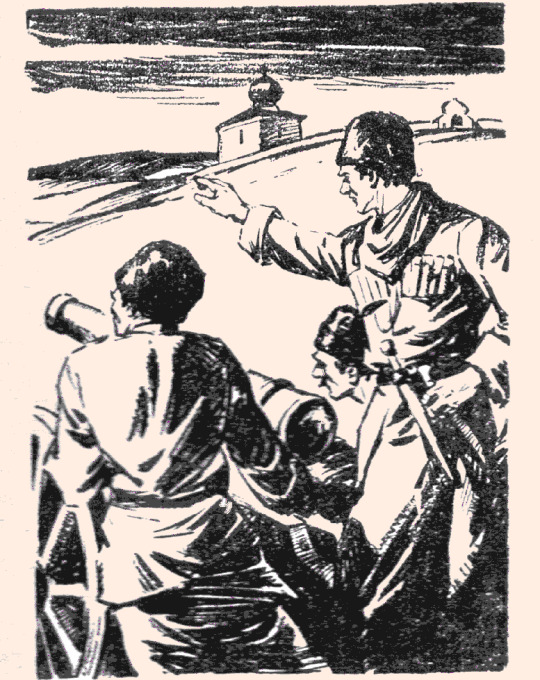
The most interesting example of this would be A. Merritt's Dwellers in the Mirage, which featured a lost city in Xinjiang that was the home of the Nordic race, who worshipped their original religion, the kraken-like squid devil god Khalkru. It was widely believed in this era that Nordics emerged from Central Asia originally, and while it's easy to write this off as turn of the century racialist claptrap pseudohistory (along with Hyperborea legends), in this case, it is actually true: a branch of the Indo-European family lived in West China, and 5,000 year old redheaded mummies have been found in the region. As usual, A. Merritt was right on the money with his archeology, more so than other 1920s authors. After all, his "Moon Pool" was set around the just discovered ruins of Nan Madol, the Venice of Micronesia.
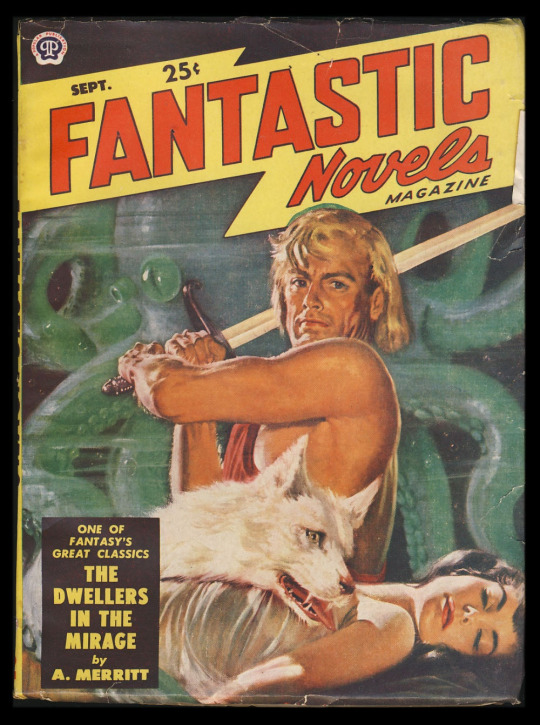
Jack Williamson's still chilling Darker Than You Think in 1948 was also set in the Silk Road/Central Asian region, as the place the race of shapeshifters emerged from, Homo magi, who await the coming of their evil messiah, the Night King, who will give them power over the human race.
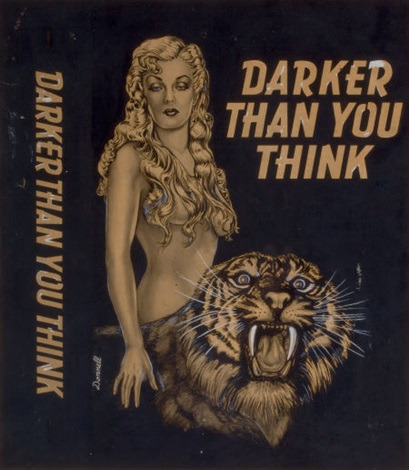
H. Rider Haggard set "Ayesha: the Return of She" (1905) in Xinjiang, among a lost Greek colony in Central Asia (no doubt based on Alexandria on the Indus, a Greek colony in modern Pakistan that was the furthest bastion of Greek Culture). This was also two years after the Younghusband Thibetan Expedition of 1903, where the British invaded Tibet. At the time, the Qing Dynasty was completely declining and lost control of the frontier regions, and the power vacuum was filled by religious authority by default (this is something you also saw in Xinjiang, where for example, the leader of the city was the Imam of Kashgar).

This is one of the many British invasions they have attempted to cram down the memory hole, but if you ever see a Himalayan art piece that was "obtained in 1903-1904" ....well, you know where it came from.
Incidentally, there's one really funny recent conspiracy theory about paleontology, fossils, and China that I find incredibly interesting: the idea that dinosaurs having feathers is a lie and a sinister plot spread by the Communist Chinese (who else?) to make American youth into sissy fancylads, like Jessie "the Body" Ventura. How? By lying to us and making up that the manly and vigorous Tyrannosaurus, a beast with off the charts heterosexuality and a model for boys everywhere, might have been feathered like a debutante's dress. What next - lipstick on a Great White Shark? The long term goal is to make Americans effeminate C. Nelson Reilly types unable to defend against invasion. This is a theory that is getting steam among the kind of people who used to read Soldier of Fortune magazine, and among abusive stepfathers the world over.
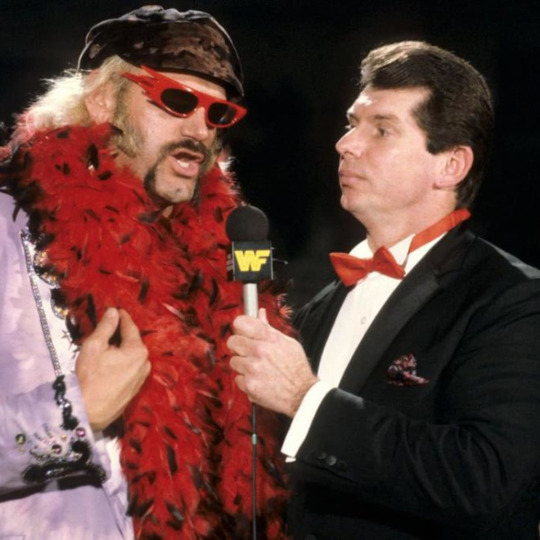
...okay, are you done laughing? Yeah, this is obvious crackpottery and transparent sexual pathology, on the level of the John Birch Society in the 60s saying the Beatles were a Communist mind control plot. Mostly because animals just look how they look, and if it turned out that the ferocious Tyrannosaurus had feathers and looked like a fancylad Jessie Ventura to you, well, that's your problem and mental baggage, really.
I was left scratching my head over this one. But there is (kind of) something to this, and that is that a huge chunk of recent dinosaur discoveries have been in China. I don't think it has anything to do with a Communist plot to turn American boys into fancylads, but more to do with a major push in internal public investment in sciences in that country, and an explosion of Chinese dinosaur discoveries. If you want to see a great undervisited dinosaur museum, go to the Zigong Dinosaur Museum in Sichuan.

Pop quiz: what living scientist has named more dinosaur discoveries? It's not Bakker or Horner. The greatest living paleontologist, Xu Xing, which is why a lot of recently found dinosaurs are named things like Shangtungasaurus.
256 notes
·
View notes
Text

Berenice Abbott at 18 rue Servandoni
The portrait on the cover of Julia Van Haaften's 2018 biography "Berenice Abbott: A Life in Photography" and at the top of Abbott's wiki page is by an unknown photographer. It was taken for the small newspaper Paris-Midi, published June 14, 1928. Keystone France agency, and now Getty owns the rights and incorrectly dates it as 1927, while Wikipedia dates it as "1930s."

At the time, her studio was at 18 rue Servandoni in Paris, we see the fireplace and door in the background in other portraits, such as the portrait of James Joyce's daughter, Lucia. There's a classic Atget at 15 rue Servandoni, but it's from 1903-4. Atget died in 1927 and Abbott, along with Julien Levy, saved his archive. By 1930 she was in New York City, where Walker Evans made his great portrait of her.
Van Haaften writes that in search of lower rent, Abbott moved to the rue Servandoni studio in early 1928. Abbott kept a clipping of the newspaper, but there's no further detail about the portrait session in the biography.
I was curious about the photographer of the portrait and found Getty has a handful of other frames from the same session that I'd never seen.

Most interesting of those frames is this contemplative shot showing the windows of her studio, maybe some photo chemicals on the table. A puff of smoke emanates from Abbott's cigarette in the same place where someone has left their fingerprint on the negative or print. There's a strong reflection or light leak in the top left corner of the frame. Van Haaften describes the rue Servandoni studio offering "beautiful north light."
Looking at the building on Google Earth, there is one north-facing spot that has the large windows similar to the 1928 portrait, seen in the center of the screen grab below.

Another detail Van Haaften mentions is that it took Abbott months to install electricity. An electric spotlight is on a tripod behind Abbott in the standing portrait. In the alternate angle you can see a not-to-code wire dangling.

So, who made these portraits? The Keystone France agency was an off-shoot of a popular stereoview company based in Meadville, Pennsylvania, hence "keystone." If you've ever flipped through old stereoviews at a vintage shop, you recognize this brand. The French agency was founded by Alexandre Garai in 1927 (whose brother Bertram started a related Keystone in London in 1914). The Met has one photograph by Alexandre Garai, taken in 1927. The jpeg is tiny, but indicates a modern perspective. While it's possible Garai is the photographer, his brother's ethos seems to have been to be the boss ... and never touch a camera.
The identity could be buried deep in Getty's London warehouse, which stores 80 million photographs and negatives. When these frames were scanned and metadata added to Getty in 2010-2016, if there was a name on the back of the prints, it probably would have been added then.
From the photos themselves, it's difficult to say if Abbott had a rapport or was familiar with the photographer: her default intensity is remarkably consistent her entire life, up until the last portrait of her in 1991.


(left, rue Servandoni 1929, right: Hank O'Neal, Berenice Abbott, Last Portrait, Monson, Maine July 17, 1991)
From the resolution, the depth of field on the lens, these are probably shot with a 4x5 or larger camera. It looks like the photographer shot the lens wide open, the camera in the standing portraits looks very much in focus, while Abbott's face looks slightly out of focus.
Two of the four frames have similar damage, could be a development problem, but could be mold later while in storage. Abbott's Paris portraits of the period were shot on glass (as much of Atget's body of work was), though by the late 1920s glass plates had mostly been replaced by film. Annoyingly, Getty is one of the best places online to see her Paris portraits, but the Steidl book is highly recommended. Seen together, you realize why Man Ray felt threatened, or at least annoyed, by his former assistant.
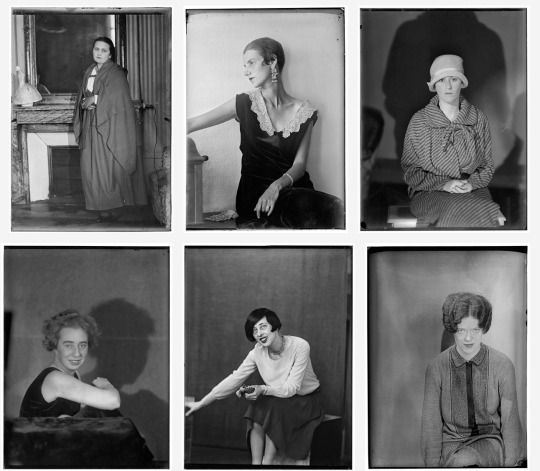
The photographer was either challenged or in a challenging environment. Abbott was often a withering critic, one can imagine a green photographer shows up to make portraits and encounters a prickly subject. With the seated portrait above, at first glance, I thought maybe the print has a piece torn out of the left side? Or is it a modern lamp intruding on the composition?
It's difficult to tell with the window portrait how much of it is a metering mistake or the potential development issue, but it looks several stops overexposed to be of use in publication of that time. Today, with our phone cameras taking three frames and digitally merging exposure, we can romanticize the top half of her body dissolving into the light is as the "magic of film."

I'm calling this the "last" frame of the session, based only on the fact that her pose and facial expression has shifted from intensity to a mix of boredom and exasperation. The photographer told her to sit on the day bed with tea and a book, "look relaxed," but she wants nothing to do with it.
31 notes
·
View notes
Text


The sharp pen of Sibyl Moholy-Nagy (1903-71) was feared by many architects throughout the 1950s and 1960s: for Progressive Architecture, Architectural Forum, Casabella, Bauwelt, Architecture d’aujourd’hui and other periodicals she wrote about contemporary architecture and didn’t hold back her criticism. Unlike many of her colleagues Moholy reflected architecture historically and took a stand for users and inhabitants, a position out of which she criticized Mies van der Rohe’s „facade architecture“.
Her way to becoming an architectural critic, teacher and frequent lecturer nonetheless was stony: born the daughter of a Dresden architect then Sibylle Pietsch, unlike her brother, wasn’t allowed to go to university but instead began an apprenticeship in bookselling which she eventually quit to become an actor in Berlin. Although she acted in different films and plays she eventually became a screenwriter, a position that suited her passion for writing. In Berlin she also met her future husband Laszlo Moholy-Nagy whom she married in 1932 and with whom she went into exile in London and Chicago. Virtually in passing she also gave birth to two daughters.
The death of her husband in 1946, in spite of all the grief, fundamentally changed Sibyl’s life and forced her into an independence that she came to embrace ever more wholeheartedly: living off the occasional sale of her husband’s artworks she had the freedom to lecture on her Laszlo’s work, organize his estate but also write his biography which to this day remains a valuable source.
In 1952 José Luis Sert lured Sibyl to New York to teach architecture at Pratt Institute, a position she received also thanks to some fibs on her CV. With her distinct autodidactic curiosity she also pursued the research into anonymous vernacular architecture that resulted in the book „Native Genius in Anonymous Architecture“, published in 1957.
This adventurous and rich life has been recounted by Hilde Heynen in her lucid and highly readable biography, published in German by Sandstein in 2019, that paints a lively and differentiated picture of a female critic, writer and teacher who was a real rarity in her time.
27 notes
·
View notes
Text
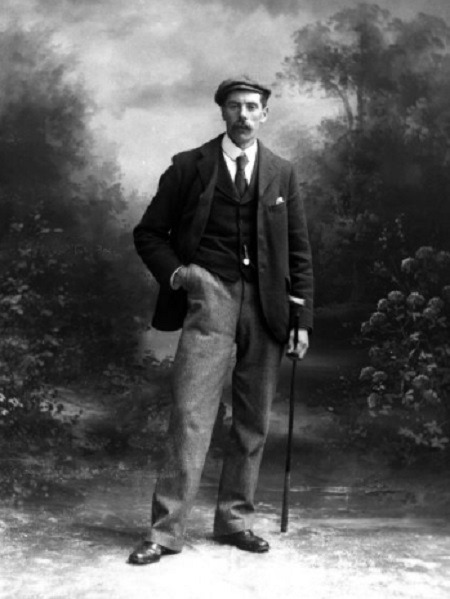



27th November 1950 saw the death of the professional golfer and golf course designer James Braid.
Born at Earlsferry in the Kingdom of Fife James Braid took up golf at an early age and played on the lovely links at Elie.
A carpenter by trade, Braid turned his skilled hands to making and repairing clubs before leaving Scotland to begin club-making at a store in London. Seizing every spare moment to play the game he loved, he steadily improved and, when 26, accepted a job as the professional at Romford Golf Club on the outskirts of London.
As a golfer e won The Open Championship in 1901, 1905, 1906, 1908 and 1910. In addition, Braid won four British PGA Matchplay Championships (1903, 1905, 1907 and 1911), as well as the 1910 French Open title. He was also runner-up in The Open Championship in 1897, 1902, 1904, and 1909. His 1906 victory in The Open Championship was the last successful defence of the title by a European until Pádraig Harrington replicated the feat in 2008. As well as the five Open wins he finished in the top five a further 11 times!
He also founded the Professional Golfers' Association and, in the midst of all his success, moved to Walton Heath, a new course to the south of London, where he remained the pro for more than 40 years until his death in 1950. While at Walton Heath, Braid found time to both write about golf and design or improve more than 200 courses throughout the U.K. Some such as Gleneagles, Carnoustie, Southport and Ainsdale, Boat of Garten and St. Enodoc are rightly famous, while others such as Aberdovey, Berkhamsted, North Hants and Goodwood are perhaps less well known, but still enjoyed nowadays by exponents of the sport.
As well as playing golf and designing courses James Braid also found time to write about it, he first articulated his philosophy in a book called "Advanced Golf," which was published in 1902. Two chapters are devoted to design and are quaintly entitled "The Planning of Course" and "The Character and Placing of Teeing Grounds, Bunkers and Putting Greens." Golf Guide, The Ladies Field Golf Book in 1908 and , How to Play Golf was in 1910. There is also a book about all the courses Braid designed as an architect titled "James Braid and his 400 courses."
Bernard Darwin’s biography James Braid was published in 1952. Darwin knew Braid for over fifty years and offers some keen insights into the man who is described as having “wisdom and a deep and essential kindness.” Regarding Braid’s ability to focus, Darwin describes him, “studying his putts as if the fate of empires depended on them,” even in casual rounds.
Braid disliked travel overseas, very rarely left the British Isles, and never traveled outside Europe, hence no American titles. But he did design two 18-hole golf courses for the Singapore Island Country Club in Asia, using topographic maps to plan his layouts there, which were then constructed to his orders.
Courses in the pic are, in order, The King's course,Gleneagles, Nairn Golf Club, Brora Golf Club, where you have some interesting hazards to play around! Championship course, Carnoustie Golf Links and Craigmillar Park Golf Club.
James Braid died on this day 1950 in Kensington and is buried at Saint Peter's Church Walton-on-the-Hill, England, he was 80 years old.
I like the epitaph on his grave, it reads , ‘He had many opponents but no enemies’
12 notes
·
View notes
Text
Beyond Band of Brothers Chapter 1 beginnings--- Dick Winters names his family and heroes and nobody else. Nobody else gets the privilege of having a name.
Then..page 13.
"During my time at OCS one of the officer candidates caught my attention. Lewis Nixon..."
Up until then they're just the school principal who made me a crossing guard and gave me a first taste of leadership. The foreman at Edison Electric who told me to not be a slacker. Dense lieutenant who doesn't know an M-1 from a 1903 Springfield. People worth mentioning but not by mentioning by name.
Then there is Lewis Nixon. Name and birthdate noted.
"Lewis Nixon was the son of privilege and wealth. Born September 20, 1918." and proceeds to fill up 5/8ths of the page on Nix. I don't even think he realizes he's doing it because he'll talk about something and then throw in a sentence "Nixon was assigned duty at Fort Ord, California, and attached to the military police on post" and then he's immediately back to his own biography.
Just an observation. :)
10 notes
·
View notes
Text
Aram Khachaturian (1903-1978)
6 notes
·
View notes
Text

IN CLASSICAL AND MODERN ART... MUSICA (Latin: Music) EXPRESSING THE DEPTHS OF THE MASCULINE SOUL!
Gauguin, Paul (1848-1903), "Cellist," Unknown Date.
The Male Form... In Photography, Art, Architecture, Decor, Style, And Culture Which Moves Beyond Mere Appearance To Reveal The... SOUL.
By LadNKilt: Earl Of Darlow, Ben Official Residence: County Antrim Northern Ireland; Main Residence: London U.K.; Second Residence: Kansas City Missouri U.S.A. LadNKilt Archive | Message Me | Submit | LadNKiltLife (Biography)
8 notes
·
View notes
Text

Art by Michael Whelan.
So, I thought I had copied and pasted "art by Michael Whelan" with the above picture of art by Michael Whelan. I...had not, and instead posted this bit of baseball trivia from somewhere on the wider world of Facebook groups algorithmically recommended to me because I seem like someone who might like an old baseball story now and then (correct, even though I don't really care about who wins now as long as the Yankees and Arizona Diamondbacks lose)...anyhow, I like the juxtaposition of SF art and baseball story.
Imagine a baseball player so eccentric that he would dash off the field mid-game to chase fire trucks. Welcome to the life of Rube Waddell, an early 1900s baseball legend whose antics are as fascinating as his athletic prowess.
Waddell's unpredictable nature made him a magnet for chaos. Opposing fans discovered his love for puppies and began bringing them to games, knowing he couldn't resist abandoning the pitcher's mound to play with the adorable distractions.
Lee Allen, a renowned sportswriter, once chronicled Waddell's 1903 season, which reads more like a Hollywood script than a sports biography. Waddell started the year sleeping in a Camden firehouse and ended it tending bar in Wheeling. In between, he won 22 games for the Philadelphia Athletics, starred in a melodrama where he improvised his lines, got married and separated, saved a woman from drowning, accidentally shot a friend, and even got bitten by a lion.
His quirks didn't end there. In 1905, his roommate and catcher, Ossee Schreckengost, demanded a clause in Waddell's contract to prevent him from eating crackers in bed—a deal-breaker born out of sharing the same bed during road trips. That same year, Waddell injured himself trying to destroy a straw hat, costing him a World Series appearance. Despite this, he clinched a Triple Crown in pitching and would have claimed the Cy Young award, had it existed, over the legendary Cy Young himself.
Waddell's life, marked by brilliance and absurdity, ended at just 37 years old due to tuberculosis, fittingly on April Fool’s Day, 1914.
----
Also: The Dollop has an episode on him and it is wonderful.

4 notes
·
View notes
Text

Alix Payen, née le 18 mai 1842, a marqué l'histoire comme ambulancière et épistolière durant la Commune de Paris en 1871. Son engagement dans l'un des épisodes les plus tumultueux de l'histoire française marque une rupture avec les conventions sociales de son époque.
Issue d'une famille bourgeoise et socialiste, elle passe son enfance en Savoie, région alors indépendante du régime de Napoléon III. Dès son plus jeune âge, Alix se distingue par son esprit indépendant et son intérêt pour les questions sociales et politiques, influencée en partie par les idéaux révolutionnaires qui circulent dans la France du XIXe siècle.
Cependant, c'est la Commune de Paris qui devient le catalyseur de son engagement actif. En 1871, lors de l'insurrection populaire qui prend le contrôle de Paris, Alix se joint aux communards, montrant un courage et une détermination exceptionnels. Durant le siège de Paris par les Prussiens en 1870-1871, puis lors de la Commune de Paris, elle s'implique activement comme ambulancière, accompagnant le bataillon de son époux et portant secours tant aux combattants de la Commune qu'aux soldats versaillais. Elle partage ainsi les conditions éprouvantes des communards, intervenant en première ligne dans les tranchées à l'ouest de Paris dès avril 1871. Sa détermination ne s'arrête pas là : elle endosse également le rôle de combattante, se battant aux côtés des hommes pour défendre les idéaux de la Commune. Son engagement va à l'encontre des normes de genre de son temps, où les rôles de combat sont presque exclusivement réservés aux hommes. Cependant, elle doit mettre un terme à son engagement sur le front à la suite de la grave blessure de son mari en mai 1871.
Après la défaite de la Commune, Alix Payen est arrêtée et fait face à la répression brutale qui s'abat sur les communards. Malgré les risques et les menaces, elle ne renonce pas à ses convictions et continue de défendre les principes pour lesquels elle a combattu.
Sa participation à la Commune est principalement documentée grâce à la correspondance qu'elle envoie à sa famille, dans laquelle elle détaille la vie quotidienne des communards et souligne le rôle des femmes dans ce mouvement insurrectionnel.
Veuve et sans ressources après la chute de la Commune, Alix se tourne vers l'art pour subvenir à ses besoins, notamment en peignant et en coloriant des photographies. Dans les années 1880, elle rejoint sa famille dans une communauté fouriériste, connue sous le nom de « La Colonie », établie dans un phalanstère à Condé-sur-Vesgre (Yvelines). Ce phalanstère, inspiré des théories socialistes utopiques de Charles Fourier, fonctionne sur le principe de coopération et de vie communautaire.
Alix continue à écrire des lettres sur sa vie au sein de cette communauté, témoignant de son parcours et de ses convictions. Sa correspondance fut ultérieurement incluse dans une biographie familiale publiée par son frère cadet dans une revue de l'époque.
Alix Payen s'éteint en 1903 à l'âge de 61 ans, laissant derrière elle un héritage important en tant que témoin et actrice de l'un des événements majeurs de l'histoire de France. Elle demeure non seulement un symbole de la participation des femmes dans les mouvements révolutionnaires, mais aussi un témoignage de la lutte pour l'égalité et la justice sociale. Sa vie, marquée par le courage, la résilience et la fidélité à ses convictions, inspire encore aujourd'hui ceux et celles qui luttent pour le changement social et l'égalité des sexes.
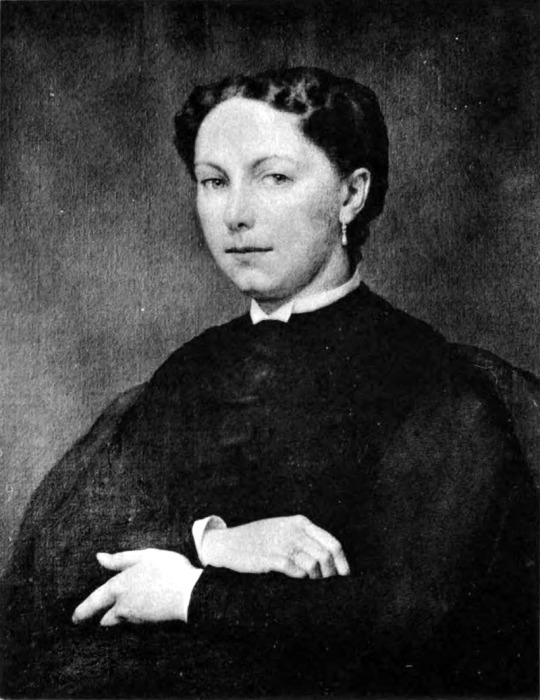
Portrait d'Alix Payen par son frère Paul Milliet.
#Alix Payen#Commune de Paris#Femme combattante#Histoire française#Egalite des sexes#Revolution#Biographie
3 notes
·
View notes
Text

"There was a winning, irresistible magnetism in the presence of this man. Except my father, there was no man in whose company I liked to be so much as in his. I had little to say to him, and demanded nothing more than a silent recognition from him, but his voice, his look, his gestures, his gait, the spiritual sphere of him, were delightful to me; and I suspect that his rise to the highest office in our nation was due quite as much to this power or quality in him as to any intellectual or even executive ability that he may have possessed. He was a good, conscientious, patriotic, strong man and gentle and tender as a woman. He had the old-fashioned ways, the courtesy, and the personal dignity which are not often seen nowadays. His physical frame was immensely powerful and athletic, but life used him hard and he was far from considerate of himself, and he died at sixty-five, when he might under more favorable conditions, have rounded out his century."
-- Julian Hawthorne, son of legendary author Nathaniel Hawthorne, on Franklin Pierce (Hawthorne and His Circle, 1903).
President Pierce and Nathaniel Hawthorne met as teenagers at Bowdoin College in Maine and were best friends throughout their lives. Hawthorne wrote Pierce's 1852 campaign biography, and Pierce appointed Hawthorne as U.S. Consul in Liverpool, England. They remained close friends after Pierce left office, and Hawthorne died while vacationing with Pierce in the White Mountains of New Hampshire in 1864.
For more on the remarkable relationship between Franklin Pierce and Nathaniel Hawthorne, check out my essay, "In Concord: The Friendship of Pierce and Hawthorne".
#History#Franklin Pierce#President Pierce#Pierce Administration#Nathaniel Hawthorne#Julian Hawthorne#Pierce and Hawthorne#In Concord: The Friendship of Pierce and Hawthorne#Presidential History#Presidents#Presidential Personalities#Presidential Friendships#New England#Politics#1852 Election#Quotes About Presidents#Presidency
13 notes
·
View notes
Text
A celebrity sighting on Seneca Lake
By Jonathan Monfiletto

Seneca Lake drew the Public Universal Friend and their followers to settle what is now Yates County and led the Society of Universal Friends to become the first permanent, non-native group of people to establish a community west of the modern-day Utica-Rome area. And ever since then, the Finger Lakes region has attracted people of all kinds for a variety of reasons; in particular, celebrities of different types and sizes have found refuge in waterfront properties along the 11 lakes.
I am well aware of all this, of course, especially the celebrity thing. I have heard the tales of Rod Serling and his family staying in their cottage on Cayuga Lake and visiting the nearby village of Interlaken, and I recall – from my days as a weekly newspaper editor – the stir created in the community by reports that Derek Jeter had purchased a mansion on Skaneateles Lake. Then, there are the many well-known people, again of different types and sizes, who are well-known locally for their residences, both permanent and season, around the region and along the lakes.
Yes, I am well aware of all this; however, I was not prepared when someone called asking me to find information about Crystal Eastman and her whereabouts in Yates County history. OK, I now know a little more about who Eastman was, which I will get to very soon, but at that point I had never heard of her. I assumed she was some sort of a relative of the woman calling, and the woman was looking for more information about her relative. Unfortunately, as I told the woman, I found little evidence that connected Eastman to Yates County. Searching our database of digitized newspapers, I uncovered just 10 mentions of Eastman in Yates County newspapers, mostly from the personals sections.
However, searching the NYS Historic Newspapers website (www.nyshistoricnewspapers.org – a wonderful resource for any genealogical and topical research within the context of New York history), I uncovered more information about Eastman and realized just what a celebrity she was in her day – quite a stalwart in the labor rights and women’s rights movements in the first quarter of the 20th century. It also appears she wasn’t from Yates County but did hail from elsewhere in the region, having grown up in Canandaigua and Elmira and then being buried in Canandaigua in her family plot upon her death.
Yet, a few of the references to Eastman in the Yates County newspapers read like reports of a celebrity sighting in the area, while others do account for her noteworthy professional career. Her biographies on Wikipedia and Find-A-Grave describe her as an antimilitarist, feminist, socialist, and journalist, having earned her law degree from New York University, received her master’s degree in sociology from Columbia University, and graduated from Vassar College in 1903. Both biographies note her roles within the fights for women’s suffrage and labor justice, both as an outsider and an insider (for example, she served on a New York State commission on employer’s liability and industrial accidents and drafted the first worker’s compensation law in this capacity). Meanwhile, her mentions in Yates County newspapers highlight her visits to the area – perhaps to see relatives and stay at their cottages.
An item under a column titled “Glenora” in the August 4, 1909 edition of the Dundee Observer notes, “Miss Crystal Eastman is spending her vacation at the Eastman cottage,” indicating she was related to the Yates County branch of the Eastman family. On September 5, the newspaper reported Eastman had returned to New York City. It is interesting to look at other newspapers to see what else was going on in Eastman’s life around the time of this excursion to Seneca Lake. In December 1908, she was admitted to the bar as a practicing lawyer with two other women in a class of 134 students. In May 1909, she spoke at a meeting of the Woman’s Trade Union League about her recent study of cases of 500 men killed in industrial accidents. Calling the federal employers’ liability laws “painfully inadequate,” she noted she found little provision made for the families of these men – putting the United States on par with Russia in this regard, she said. The next month, the New York governor appointed her to a committee to study employers’ liability and the causes and effects of unemployment in the state. The month after she returned from Glenora, she appeared as a speaker at the Greater New York Woman Suffrage Convention at Carnegie Hall. In March 1910, she testified – along with other notable people on either side of the women’s suffrage question – at a hearing of the New York Legislature on whether to give women the right to vote statewide.
The April 26, 1911 edition of the Yates County Chronicle and the April 28, 1911 edition of the Rushville Chronicle carried identical announcements of Eastman’s engagement to her first husband, Wallace Benedict, of Milwaukee, Wisconsin. Listing Eastman as of Elmira, these reports seem to show Yates County residents would have been interested in the whereabouts of this relatively local person. Around this time, she continued to advocate for fair labor laws and practices – such as a nine-hour workday for women – through her work with New York State. After her marriage, it appears she moved to her husband’s home state and championed the cause of women’s suffrage there.
On March 3, 1913 – as reported locally in the Penn Yan Democrat – Eastman took part in the Woman Suffrage Procession as one of four horsewomen forming a relay into Washington, D.C. to herald the progress of the procession. That October, she was added to the staff of the Federal Labor Commission and continued to advocate for workers, women, and working women. This included, according to the June 2, 1915 edition of the Penn Yan Express, a stint in charge of the saleswomen’s bureau for the Maxwell Motor Company as the automobile manufacturer sought to employ women to sell its cars to other women.
Around this time, she also took at least two more trips to Glenora – first as Mrs. Crystal Eastman Benedict, of Milwaukee, according to the June 30, 1915 edition of the Dundee Observer and then, after her divorce and remarriage, as Mrs. Crystal Eastman Fuller, of New York, according the newspaper’s August 8, 1918 issue. Interestingly, newspapers in the intervening years highlight Eastman’s denial of alimony from her first husband as her way of asserting her independence and self-sufficiency. She felt women should show their ability to support themselves by rejecting assistance from their ex-husbands. At the same time, as the Great War broke out in Europe and eventually the United States joined the conflict, Eastman became involved in the Women’s Peace Party and its activities and events. The group opposed that war and any war or militaristic preparations for war.
Of course, there is much more – and always more – to say about Eastman’s life, times, and work, as I have discovered in my brief research of her. For example, she was recently celebrated locally for her role in co-authoring the Equal Rights Amendment. This is just a glimpse of her through the lens of Yates County newspaper coverage, with a celebrity sighting on Seneca Lake.
#history#historyblog#archives#museum#american history#us history#local history#yatescounty#newyork#womens rights#labor rights#glenorany#senecalake
3 notes
·
View notes
Text

Kamer Aga-Oglu via the University of Michigan. This comes from a very good summary biography of her life .
"Kamer Aga-Oglu was curator of the Museum’s Asian collections from 1945 to 1974. An extraordinary scholar, Aga-Oglu single-handedly transformed the study of Asian ceramics, focusing particularly on understudied Asian trade wares in the Museum’s collections.
Aga-Oglu was born on October 15, 1903, in Shusha in the Republic of Azerbaijan, and she completed her early schooling in Baku in the South Caucasus. In 1921, following years of violence and the Bolshevik invasion, her family fled on foot to Turkey and then to Western Europe. "
4 notes
·
View notes